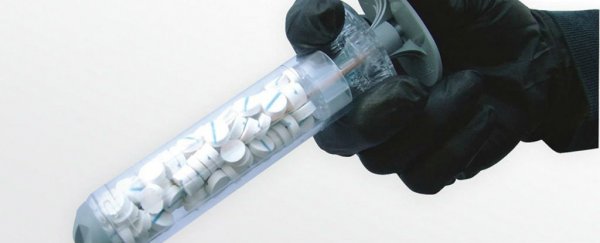A syringe filled with sponges that expand upon release to stop a gunshot wound from bleeding in 20 seconds flat will soon be made available to ambulance staff in the US.
Developed by Oregon-based technology company, RevMedx, the $100 device has just been approved by the Federal Food and Drug Administration (FDA) for public use, and has been successfully employed by the US military since April 2015. Named XSTAT 30, it's hoped that it will prevent fatalities by halting serious blood flow till the patient can get to the emergency ward.
"XSTAT 30 is cleared for use in patients at high risk for immediate, life-threatening, and severe hemorrhagic shock and non-compressible junctional wounds, when definitive care at an emergency care facility cannot be achieved within minutes," the FDA announced in a press statement.
The 30 mm-diameter syringe is filled with 92 compressed cellulose sponges covered in an absorbent coating and coagulant. These tablet-shaped sponges measure 9.8 millimetres in diameter and can absorb 3 millilitres of blood or body fluid each. As soon as they come into contact with blood, the sponges rapidly expand to about 10 times their original size, and swell to fill the wound cavity in about 20 seconds to form a temporary blockage for the blood flow.
According to RevMedx, the device can stop the bleeding for about four hours, and up to three applicators can be used if the wound is particularly severe. It's super effective, because rather than applying pressure to the wound from the outside - like you would if you wrapped it tightly with a bandage - the pressure comes from inside the wound to address every potential site of bleeding. Each sponge contains a radiopaque marker so it can be easily detected with x-ray imaging.
"We designed the XSTAT with direct input from military medics and first responders to provide a unique solution to the issue of junctional haemorrhage," Andrew Barofsky, CEO and president of RevMedx, said on their website.
While tourniquets - special bandages used to constrict or compress an area of the body to restrict arterial circulation - do a similar job, they can't be used everywhere, for example on the groin or armpit. These areas are perfect for XSTAT 30, says the FDA, but the new device is not suited to treating gunshot wounds on parts of the chest, pelvis, abdomen, or just above the collarbone.
"According to the US Army Medical Department, Medical Research and Materiel Command, since mid-World War II, nearly 50 percent of combat deaths have been due to exsanguinating haemorrhage (bleeding out)," the FDA said back in April. "Of those, half could likely have been saved if timely, appropriate care had been available."
According to the video below, gunshot wounds usually take around 3 or 4 minutes to compress and block off, during which time a life-threatening amount of blood can often be lost. Cutting this time down to mere seconds is expected to have a significant impact on recovery time.
